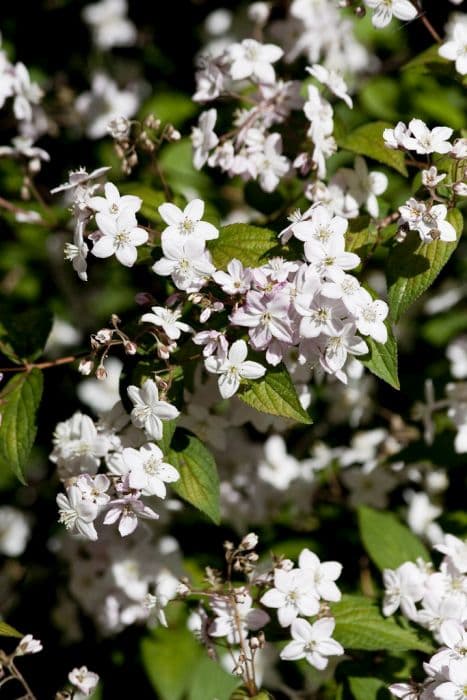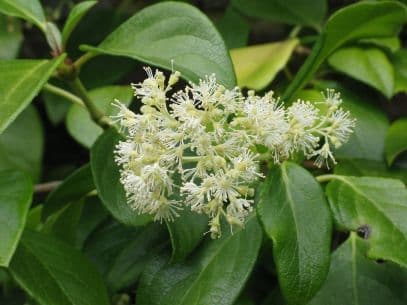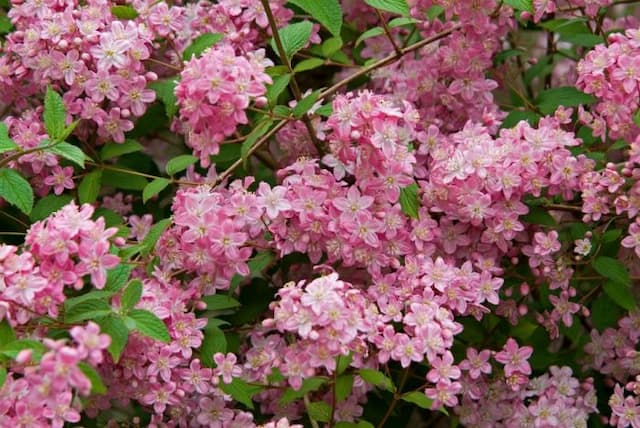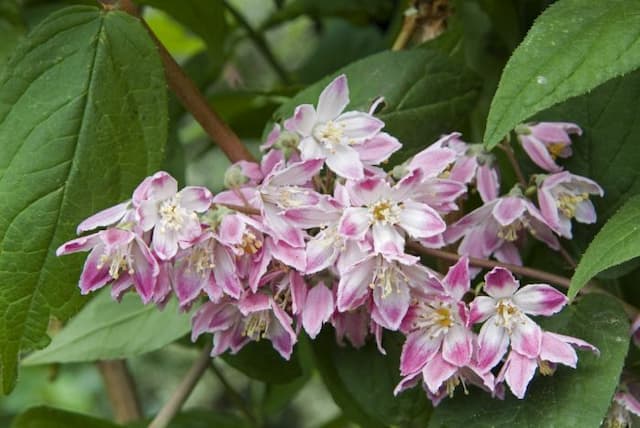Littleleaf Mock Orange Philadelphus microphyllus

ABOUT
The plant commonly known as littleleaf mock orange is a deciduous shrub renowned for its pleasing aesthetics and fragrant flowers. The foliage is dense, with numerous small, oval-shaped leaves that have a fresh, green hue. The edges of the leaves are delicately toothed, giving the foliage a slightly textured appearance that catches the light and adds interest. The most striking feature of littleleaf mock orange is its abundant flowers. The blossoms are conspicuous and creamy white, exuding a rich, sweet fragrance that can perfume the air around the shrub. Each individual flower resembles a small, classic wild rose with multiple petals arranged in a loose, informal way that contributes to the plant's overall charm. The blooms are typically clustered in groups, creating a showy display that is particularly eye-catching during the blooming season. The bark of the shrub is another notable feature, with a color that can be best described as a subtle brown with a slightly roughened texture that provides a pleasing contrast to the softer foliage and flowers. Overall, the littleleaf mock orange is admired for its combination of dainty leaves, beautifully scented flowers, and the effortless grace it lends to any landscape setting where it’s grown. It's a plant that can truly enliven one's garden, offering both visual beauty and olfactory delight.
About this plant
 Names
NamesFamily
Hydrangeaceae.
Synonyms
Littleleaf Mock Orange, Desert Mock Orange.
Common names
Philadelphus microphyllus var. microphyllus, Philadelphus sericanthus.
 Toxicity
ToxicityTo humans
Littleleaf mock orange is generally considered non-toxic to humans. Therefore, ingestion of this plant typically does not lead to any significant symptoms of poisoning or negative consequences. However, it is always advisable to exercise caution and avoid ingesting plants that are not known to be edible, as individual allergic reactions or stomach upset could occur.
To pets
Littleleaf mock orange is not known to be toxic to pets. It does not contain any known toxic compounds that would typically cause symptoms of poisoning in animals upon ingestion. As with humans, while the plant is not considered poisonous, it is wise to prevent pets from ingesting it to avoid the possibility of an unexpected allergic reaction or gastrointestinal discomfort.
 Characteristics
CharacteristicsLife cycle
Perennials
Foliage type
Deciduous
Color of leaves
Green
Flower color
White
Height
3-4 feet [0.9-1.2 meters]
Spread
3-4 feet [0.9-1.2 meters]
Plant type
Shrub
Hardiness zones
5
Native area
North America
Benefits
 General Benefits
General Benefits- Aesthetic Appeal - Philadelphus microphyllus, commonly known as Littleleaf Mock Orange, has beautiful white flowers that are often fragrant, adding a delightful scent and visual interest to the garden.
- Wildlife Habitat - It provides shelter and nesting sites for birds, and the flowers can attract pollinators such as bees and butterflies.
- Low Maintenance - Littleleaf Mock Orange is known for being drought-tolerant once established and requires minimal care, making it a convenient choice for gardeners.
- Natural Border - Its bushy growth habit makes it suitable for use as a natural hedge or border plant, offering privacy and structure in landscape design.
- Erosion Control - The plant's root system can help stabilize soil and prevent erosion on slopes.
- Seasonal Interest - Besides its spring blooms, Littleleaf Mock Orange can provide seasonal color changes in its foliage during the fall.
 Medical Properties
Medical PropertiesThis plant is not used for medical purposes.
 Air-purifying Qualities
Air-purifying QualitiesThis plant is not specifically known for air purifying qualities.
 Other Uses
Other Uses- Insect Repellant: Philadelphus microphyllus, commonly known as littleleaf mock orange, can be used to repel certain insects when branches are hung in doorways or windows.
- Hedge Plant: Its dense foliage makes it suitable for creating living fences or privacy screens in gardens and parks.
- Perfumery: The flowers' sweet fragrance can be used in the making of perfumes and scented oils.
- Culinary Decoration: The flowers of littleleaf mock orange can be used as an attractive and aromatic garnish for various dishes and desserts.
- Photography: Its picturesque blossoms are often sought after by photographers for use in floral and garden imagery.
- Artistic Inspiration: Artists may use the delicate appearance of flower clusters as subjects for painting, drawing, or other forms of artwork.
- Erosion Control: The root system of littleleaf mock orange can help stabilize soil in erosion-prone areas.
- Wildlife Habitat: By providing shelter and food (nectar), it contributes to the support of local wildlife populations, including birds and beneficial insects.
- Educational Tool: Due to its various features and easy cultivation, it can be used by schools and educational programs to teach students about plant biology and horticulture.
- Craft Material: Dried branches of littleleaf mock orange can be used in making wreaths, arrangements, or other craft projects.
Interesting Facts
 Feng Shui
Feng ShuiThe Mock Orange is not used in Feng Shui practice.
 Zodiac Sign Compitability
Zodiac Sign CompitabilityThe Mock Orange is not used in astrology practice.
 Plant Symbolism
Plant Symbolism- Renewal: Philadelphus microphyllus, commonly known as the Littleleaf Mock Orange, is symbolic of renewal because of its vigorous growth and the way it refreshes the landscape with its abundant white blooms.
- Innocence: The pure white flowers of the Littleleaf Mock Orange are often associated with innocence, echoing the simple and untainted beauty that the plant represents.
- Brotherly Love: The genus name 'Philadelphus' derives from Greek words 'philos', meaning love, and 'adelphos', meaning brother, indicating a symbolic meaning of brotherly love or strong fraternal bonds.
 Water
WaterFor the Littleleaf Mock Orange, water deeply and thoroughly to ensure the roots can access moisture without staying waterlogged. During the growing season, water once a week with about 1 to 1.5 gallons, depending on the climate and weather conditions. In hot, dry periods, you may need to increase the frequency to twice a week. Always check the soil moisture before watering; it should be moist but not saturated. Reduce watering in the winter when the plant is dormant to biweekly or only when the soil is dry to the touch.
 Light
LightLittleleaf Mock Orange thrives best in full sun to partial shade conditions. It should receive at least six hours of direct sunlight per day. An ideal spot would be in a garden that gets morning sun and afternoon shade, protecting it from the intense heat of late-day sun.
 Temperature
TemperatureThe Littleleaf Mock Orange prefers a temperate climate and can survive a range of temperatures. It can withstand minimum temperatures down to about 10 degrees Fahrenheit and is comfortable in maximum temperatures up to 100 degrees Fahrenheit. For optimal growth, maintain a temperature range between 60 and 75 degrees Fahrenheit.
 Pruning
PruningPrune the Littleleaf Mock Orange immediately after it finishes blooming to maintain its shape and encourage healthy growth. This typically equates to once a year pruning. Cut back approximately one-third of the old wood to allow light and air circulation, promoting new shoots and better blooms next season. The best time for pruning is late spring or early summer, just after the flowering period.
 Cleaning
CleaningAs needed
 Soil
SoilThe Littleleaf Mock Orange prefers well-draining soil rich in organic matter with a pH range of 6.0 to 8.0. A mixture incorporating equal parts garden soil, compost, and perlite or coarse sand is ideal to provide the necessary drainage and nutrition.
 Repotting
RepottingLittleleaf Mock Orange does not require frequent repotting and should generally be repotted every 2 to 3 years. It's best to repot in the spring just before the new growth begins.
 Humidity & Misting
Humidity & MistingLittleleaf Mock Orange tolerates a wide range of humidity levels typical of outdoor environments but does not require any special humidity considerations when grown outdoors.
 Suitable locations
Suitable locationsIndoor
Place in bright, indirect light and ensure medium humidity.
Outdoor
Plant in full sun to part shade, sheltered from strong winds.
Hardiness zone
5-8 USDA
 Life cycle
Life cyclePhiladelphus microphyllus, commonly known as 'littleleaf mock orange,' begins its life cycle from seed, which requires stratification to break dormancy and germinate. Upon sprouting, the seedling develops primary leaves and a root system, transitioning into a juvenile vegetative phase where it focuses on growth. As the plant matures, it enters the adult vegetative stage, forming a woody stem and the dense, fine-textured foliage characteristic of mature mock oranges. Flowering occurs in late spring to early summer, with the plant producing fragrant, white flowers that attract pollinators for sexual reproduction. After pollination, small four-chambered fruit capsules develop, containing the seeds for the next generation. Throughout its life, littleleaf mock orange will enter periods of dormancy during colder months, resuming growth and flowering in subsequent seasons.
 Propogation
PropogationPropogation time
Spring to early summer
Propogation: The Mock Orange (Philadelphus microphyllus) is most commonly propagated through softwood cuttings. This method involves taking cuttings from new growth in late spring or early summer, when the stems are green and flexible, typically around 4 to 6 inches long. The leaves on the lower half of the cuttings should be removed and the base dipped in rooting hormone to encourage root development. The cuttings are then placed in a well-draining soil mix and kept moist under high humidity, which can be created by covering the pot with a plastic bag. Roots usually form within 4 to 8 weeks, after which the new plants can be gradually acclimatized to less humid conditions before being transplanted outdoors.



![Hydrangea [Pink Annabelle] ('Ncha1')](/_next/image?url=https%3A%2F%2Fplants-admin.emdemapps.com%2Fimages%2Fplants%2F%2Fimages%2F604b576c63619.png&w=640&q=75)





